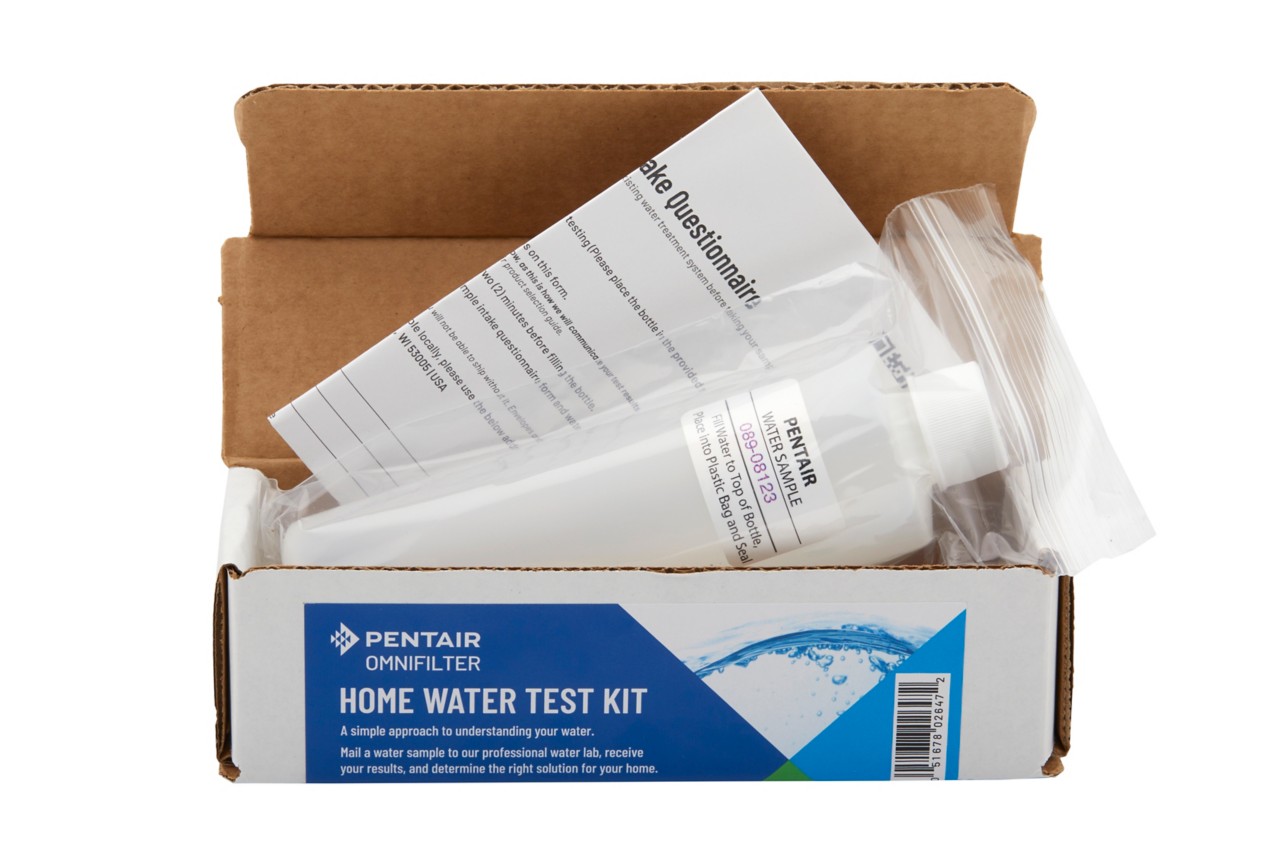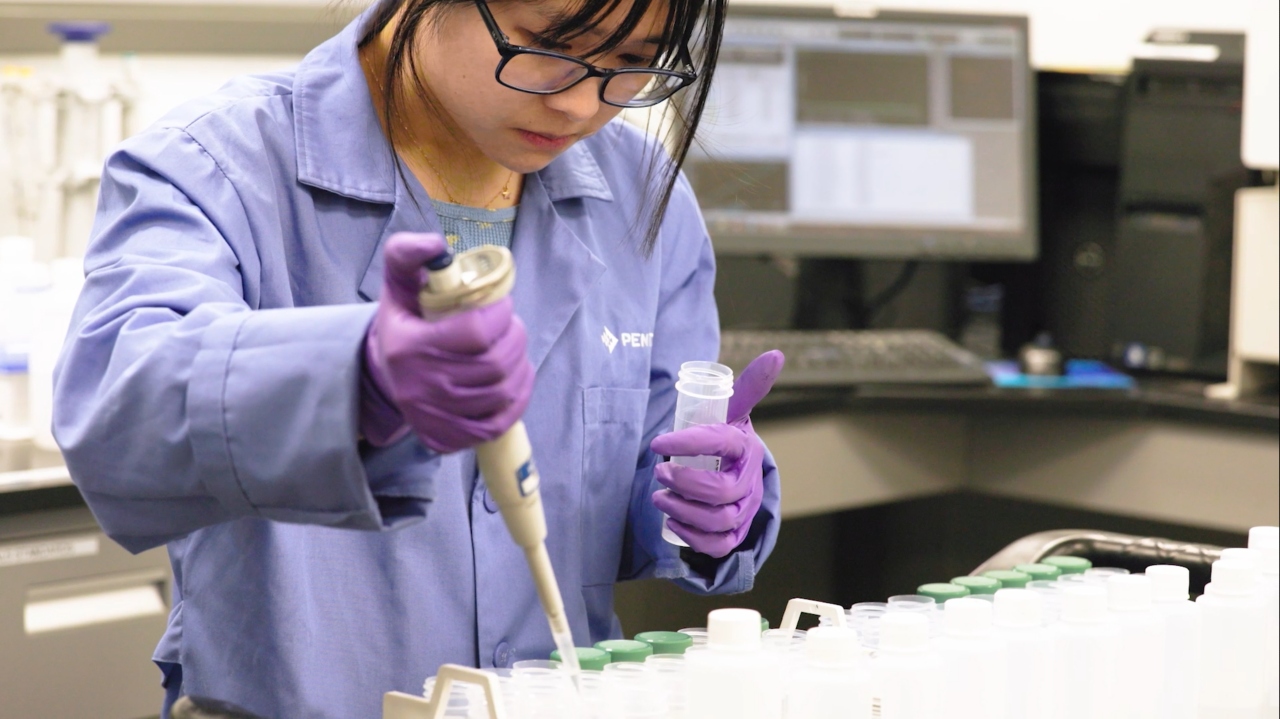- Water Filtration Systems
- Water 101
- Water Testing Lab
The Pentair water testing lab
Uncover what's in your water. Water testing empowers you to understand your home's plumbing and make informed decisions. Lead, nitrates, and bacteria can be hidden threats, potentially impacting the quality of your water.
Pentair doesn't stop at results; we leverage our expertise to analyze your data and recommend a personalized water solution. Our water testing lab empowers you to optimize your water quality.

Our Water Testing Lab Capabilities
Our water testing lab plays a critical role in improving the quality of water for our customers. Here's an overview of our water testing capabilities.
Analyze water samples for contaminants
We offer comprehensive water testing for a wide range of impurities, minerals and chemicals. Gain peace of mind and ensure your water's quality.
We utilize various testing methods:
- Microbiological tests: We identify bacteria and other microorganisms that may indicate contamination.
- Chemical tests: We measure the concentration of different chemicals and minerals present in the water.
- Physical tests: We assess factors like turbidity, color, odor, and temperature.
We interpret results and provide a personalized water solution:
- We compare results to established safety standards or regulations.
- We identify any contaminants exceeding acceptable levels.
- We provide treatment options or further investigations, depending on the specific situation.
Additional services:
- Our teams offer on-site water sampling or consulting services for commercial water applications.
- We can save time and money by diagnosing issues with existing water treatment systems, recommending a better water treatment system as needed, and supporting our customers with ongoing care and maintenance. Pentair's water testing labs play a vital role in safeguarding public health, protecting the environment, and ensuring the quality of water for various uses.
Pentair's water testing labs play a vital role in safeguarding public health, protecting the environment, and ensuring the quality of water for various uses.
What's in your water?
start here
Worried about your water? Take control with our at-home water test kit. We'll analyze your water and recommend the best filtration or softening solution for your specific needs.

What we test for
-
Alkalinity
-
Homeowners should test for alkalinity in their water for several reasons:
Protecting Pipes and Appliances:
- Corrosion: Low alkalinity water is corrosive, meaning it can eat away at metal pipes and appliances, leading to leaks, damage, and costly repairs. Testing helps identify this risk and allows for treatment options like adding baking soda to raise alkalinity.
- Scale Buildup: High alkalinity water can contribute to scale buildup in pipes, fixtures, and appliances, reducing efficiency and lifespan. Testing allows for adjustments like using water softeners or installing filters to manage scale formation.
Ensuring Optimal Water Quality:
- Taste and Odor: High alkalinity can give water a soapy or bitter taste. Testing helps identify this issue and allows for treatment like filtration to improve taste and odor.
- Effectiveness of Water Treatment: Understanding alkalinity levels helps ensure the effectiveness of water treatment systems like reverse osmosis or filters. Knowing the initial alkalinity allows for optimal settings and maintenance of these systems.
Peace of Mind:
- Proactive Approach: Regularly testing for alkalinity, along with other contaminants, empowers homeowners to make informed decisions about their water quality and take preventative measures to protect their pipes.
Additional considerations:
- The ideal alkalinity range depends on various factors like location, water source, and household needs. Consulting with Pentair's network of water treatment professionals can help interpret results and recommend appropriate actions.
-
Arsenic
-
There are key reasons why testing for arsenic in water is crucial:
- Compliance with Drinking Water Standards: Many countries and regions have established maximum allowable arsenic levels in drinking water.
- Public Awareness: Regular testing and reporting of arsenic levels in public water supplies help raise awareness about this potential hazard and encourage informed choices by consumers.
Overall, testing for arsenic in water is crucial for identifying and mitigating contamination and ensuring better drinking water for all.
-
Chloramines
-
Testing for chloramines in water is important for several reasons, depending on your perspective:
Public Water Suppliers:
- Maintaining Disinfection: Chloramines are disinfectants commonly used in water treatment for their long-lasting stability and ability to control certain contaminants not effectively tackled by chlorine alone. Regular testing ensures adequate chloramine levels for continuous disinfection.
- Optimizing Treatment: Monitoring chloramine levels allows water providers to adjust their treatment processes efficiently, minimizing the formation of byproducts and ensuring optimal control of disinfection.
- Regulatory Compliance: Many countries and regions have established maximum allowable chloramine levels in drinking water.
Homeowners and Businesses:
- Understanding Water Quality: Knowing the chloramine level in your water informs you about the disinfection method used and its potential implications. For example, some people find chloramines create an undesirable taste or odor in water, and understanding the level can help with mitigation strategies.
- Maintaining Water Treatment Systems: If you use filtration systems or appliances sensitive to chloramines (e.g., certain fish tanks, dialysis machines), knowing the level allows you to adjust settings or choose appropriate filters for optimal performance and lifespan.
- Protecting Specific Needs: In cases where individuals have respiratory issues or specific sensitivities to chloramines, knowing the level helps them make informed decisions about water usage or potentially seek alternative water sources.
-
Chlorine, Free
-
Testing for chlorine is good for various reasons:
In Drinking Water:
- Ensuring Disinfection: Free chlorine is the primary disinfectant used in most public water supplies. Testing verifies its presence at sufficient levels to kill harmful bacteria and viruses.
- Maintaining Balance: Too much free chlorine can be harsh and create unpleasant taste and odor, while too little compromises disinfection effectiveness. Testing ensures its concentration stays within the effective range.
- Optimizing Treatment: Monitoring free chlorine helps water treatment plants adjust their dosage precisely, minimizing unnecessary chemical use and potential byproducts while still ensuring proper disinfection.
Homeowners with Private Wells:
- Monitoring Disinfection Systems: If you use chlorine-based systems for well disinfection, testing confirms their effectiveness and allows for timely adjustments if needed.
-
Chlorine, Total
-
Testing for total chlorine is important to gain a more complete picture and take necessary actions. Here's why:
Understanding the Bigger Picture:
- Combined Chlorine: Total chlorine encompasses both "free chlorine," the active disinfectant, and "combined chlorine" (chloramines). Combined chlorine forms when free chlorine reacts with ammonia or other organic matter in the water. While it has some disinfecting ability, it's weaker and can cause unpleasant taste and odor. Testing for total chlorine reveals the combined chlorine presence, indicating potential issues with disinfection efficiency and taste concerns.
- Effectiveness Assessment: Free chlorine levels might seem adequate, but high combined chlorine signifies inefficiencies or insufficient free chlorine conversion. By understanding the total chlorine composition, you can adjust treatment processes (e.g., shock treatment) to optimize disinfection and minimize combined chlorine formation.
- Compliance and Regulations: In some situations, regulations might define limits for both free and total chlorine
Overall, testing for total chlorine provides valuable insights beyond just free chlorine levels. It empowers informed decision-making to optimize disinfection effectiveness, address odor and taste issues and comply with regulations.
Additional points:
- Remember, the correct ratio of free to combined chlorine is key. Consult Pentair's network of water treatment professionals for guidance on interpreting test results and taking appropriate actions based on your specific context.
- Regular testing of both free and total chlorine is recommended for comprehensive water quality management.
-
Copper
-
Maintaining Water Quality:
- Aesthetics: Elevated copper levels can cause unpleasant metallic taste, odor, and blue-green staining in water and plumbing fixtures, impacting the overall water quality experience.
- Corrosion Concerns: Copper often leaches from corroded pipes into water, especially in older plumbing systems. Testing reveals copper, allowing for repairs or proactive measures to prevent further contamination and potential damage to pipes.
- Protecting Appliances: Excessive copper can damage sensitive water-using appliances like dishwashers and washing machines. Testing and managing copper levels can extend their lifespan and reduce maintenance costs.
-
Fluoride
-
Managing potential hazards:
- Overexposure Risks: While beneficial at the right level, too much fluoride can lead to dental fluorosis, causing cosmetic staining and enamel defects.
- Compliance with Regulations: Most countries and regions have established maximum allowable fluoride levels in drinking water.
-
Hardness
-
Household Impact:
- Scale Buildup: Hard water, rich in minerals like calcium and magnesium, forms scale when heated. This can damage appliances like water heaters, dishwashers, and washing machines, reducing their lifespan and efficiency. Testing helps identify potential issues and plan preventative measures like installing softeners or adjusting detergent use.
- Soap and Cleaning Product Inefficiency: Soap and detergents struggle to lather in hard water, requiring more product to achieve desired results. This increases costs and can leave residue on skin, hair, and dishes. Understanding hardness helps adjust cleaning routines and product choices for optimal results.
- Skin and Hair Concerns: Some people find hard water dries out skin and hair, leading to itchy skin, dull hair, and difficulty styling. Knowing the hardness level allows for adjustments like using hydrating products or installing softening filters.
Water Management:
- Corrosion: While hard water offers some corrosion protection, overly soft water can be corrosive to pipes and plumbing fixtures.
Overall, testing water hardness empowers informed decisions to protect appliances, ensure efficient cleaning, address skin and hair concerns, and optimize water treatment systems.
-
Iron
-
While iron is an essential mineral for our bodies, its presence in water, even at relatively low levels, can lead to various problems. Testing for iron in water is crucial for several reasons:
Impacts on Aesthetics and Household Function:
- Unpleasant Taste and Odor: Iron imparts a metallic taste and rusty smell to water, making it unappealing for drinking and cooking.
- Staining: Iron can leave reddish-brown stains on laundry, dishes, and plumbing fixtures, detracting from aesthetics and requiring additional cleaning efforts.
- Clogged Pipes: Over time, iron deposits can build up in pipes and appliances, reducing water flow and potentially causing blockages.
Protecting Appliance Functionality:
- Reduced Appliance Lifespan: Iron deposits can damage water heaters, washing machines, and other appliances, leading to premature failure and costly repairs or replacements.
Overall, testing for iron in water empowers informed decision-making. By understanding its presence and potential impacts, you can:
- Improve Water Quality: Implement treatment solutions like filtration or aeration to reduce iron, enhancing the taste, odor, and clarity of your water.
- Protect Appliances: Take preventative measures to extend the lifespan of your water-using appliances.
- Ensure Compliance: Meet local regulations and contribute to drinking water standards.
- Make Informed Choices: Choose appropriate water sources or treatment options based on your iron levels and preferences.
Additional points:
- The severity of iron-related problems depends on the concentration in your water.
- Consult a Pentair water treatment partner for guidance on interpreting test results and choosing appropriate treatment solutions.
-
Lead
-
Identifying the Source:
- Multiple Potential Sources: Lead can enter your home's water through various sources, including lead pipes, solder in older plumbing, and brass fixtures. Testing helps pinpoint the source of contamination, directing targeted remediation efforts.
- Taking Necessary Action: Based on the test results, you can take appropriate action like replacing lead pipes, installing filters, or finding alternative water sources to reduce the lead exposure risk.
Regulatory Compliance:
- Lead and Copper Rule: Many regions have regulations like the Lead and Copper Rule in the US, requiring testing for lead in public water supplies and some private wells.
Additional points:
- Even if your home was built after lead pipes were banned, there might still be lead solder or brass fixtures contributing to contamination.
- Testing options range from DIY kits to professional analysis, offering varying levels of accuracy and detail. For best results, consult with a Pentair water treatment partner for guidance on testing and remediation measures.
-
Manganese
-
Impacting Water Quality:
- Unpleasant Taste and Odor: High manganese levels can impart a metallic or bitter taste and an unpleasant odor to your water, making it unappealing for drinking and cooking.
- Staining: Manganese can cause brown or black staining on laundry, dishes, and plumbing fixtures, detracting from aesthetics and requiring additional cleaning efforts. Understanding your manganese levels allows for appropriate water treatment choices to prevent staining.
Additional Benefits:
- Compliance with Regulations: In some regions, there might be regulations for manganese levels in drinking water. Testing ensures compliance with these regulations and helps avoid potential issues.
Additional points:
- Professional laboratory analysis, like the Pentair Water Lab, offers the highest level of accuracy and detail.
- By being mindful of the importance of manganese testing and taking necessary actions, you can ensure a more enjoyable water experience for yourself and your family.
-
Nitrate
-
Understanding Water Quality:
- Identifying Contamination Sources: Nitrates naturally occur in soil and water. However, agricultural practices, fertilizers, and septic systems can increase levels. Testing helps pinpoint potential contamination sources and allows for informed decisions about water treatment or seeking alternative water sources.
- Monitoring Effectiveness of Treatment Aystems: If you use a nitrate removal system, regular testing ensures its effectiveness and informs when maintenance or replacement is needed.
Additional Considerations:
- Regulations and Recommended Limits: Most regions have established maximum permissible nitrate levels in drinking water.
- Taking Action: Depending on your test results, actions might include seeking alternative water sources, installing Pentair water treatment systems, or adjusting agricultural practices if relevant.
-
pH
-
Protecting Pipes and Appliances:
- Corrosion: Water with excessively high or low pH levels can be corrosive, eroding metal pipes and damaging appliances like water heaters and dishwashers. This can lead to leaks, reduced lifespan, and costly repairs. Testing helps identify potential concerns and allows for adjustments like adding baking soda (for low pH) or vinegar (for high pH) to neutralize the water and help prevent damage.
- Scale Buildup: Hard water with high pH tends to form scale deposits in pipes and appliances, reducing water flow and efficiency. Understanding pH helps determine if a water softener is necessary to prevent these issues and protect your plumbing system.
Ensuring Optimal Water Quality:
- Taste and Odor: Water with imbalanced pH can have an unpleasant taste, metallic tang, or soapy feel.
- Effectiveness of Water Treatment: Understanding your water's pH aids in choosing and maintaining the right water treatment solutions. For example, reverse osmosis systems perform best with specific pH ranges, and knowing your levels ensures optimal performance and efficiency.
Peace of Mind:
- Proactive Approach: Regularly testing pH empowers you to proactively address potential issues before they cause damage or impact your water quality. This provides peace of mind and allows for informed decisions regarding your water management and appliance lifespan.
Additional points:
- The ideal pH range for drinking water is between 6.5 and 8.5. Consult with your local Pentair water treatment professionals for specific guidance based on your local context.
- Professional analysis, done through the Pentiar water lab, offers the most accuracy and detail.
- Remember, maintaining proper pH alongside other water quality parameters like hardness and chlorine levels contributes to a holistic approach to water management at home.
-
Total Dissolved Solids
-
Understanding Water Quality:
- General Indicator: TDS measures the total amount of dissolved minerals and inorganic substances in water. While not conclusive, a high TDS value might indicate potential concerns like hardness, salinity, or contamination.
- Taste and Odor: High TDS can contribute to an unpleasant taste or odor in water due to mineral content. Testing helps identify such issues and allows for filtration solutions to improve your water's palatability.
Managing Appliances and Plumbing:
- Scale Buildup: High TDS often signifies hard water, prone to forming scale deposits in pipes and appliances.
- Corrosion: While less common, very low TDS water can be corrosive to metal pipes. If concerned about low TDS levels, consult a water treatment professional for specific recommendations.
Making Informed Decisions:
- Seeking Alternative Sources: If your TDS level is concerning, further testing for specific contaminants and consulting with professionals can help you decide if seeking alternative water sources is necessary.
- Choosing Filtration Systems: Understanding your TDS level can guide you in choosing the right filtration system for your needs. Some systems may be more effective than others depending on the specific components contributing to your high TDS.
Overall, testing for TDS offers valuable insights into your water's overall mineral content and can be a helpful indicator for potential issues like hardness or taste concerns. However, it's crucial to interpret TDS results in conjunction with other tests and professional guidance to ensure comprehensive water quality understanding and informed decision-making for your household.
-
Turbidity
-
While not mandatory in all situations, testing for turbidity in your water as a homeowner offers several valuable benefits and peace of mind:
Understanding Water Quality:
- Indicator of Potential Problems: Turbidity measures the cloudiness of water caused by suspended particles like clay, silt, organic matter, or even microorganisms. While not directly harmful itself, high turbidity can signify various issues affecting your water quality.
- Early Detection: Regular testing allows for early detection of potential problems like increased pollution, malfunctioning treatment systems, or issues with your well or plumbing.
Aesthetic Concerns:
- Unpleasant Appearance: Cloudy water is visually unappealing and might deter people from drinking it, potentially leading to dehydration. Testing helps identify and address such aesthetic concerns, encouraging proper hydration.
- Taste and Odor: High turbidity can sometimes affect the taste and odor of your water, making it less pleasant to consume. Identifying these concerns through testing allows for implementing solutions like filtration to improve palatability.
Protecting Appliances and Plumbing:
- Sediment Buildup: Over time, suspended particles causing turbidity can settle and accumulate in pipes and appliances, reducing water flow and efficiency. Testing helps identify potential issues and allows for cleaning or maintenance before facing major problems.
- Corrosion: While less common, high turbidity can sometimes exacerbate corrosion in aging pipes. Identifying this risk through testing allows for taking necessary measures to protect your plumbing system.
Making Informed Decisions:
- Maintaining Well Systems: For homeowners with private wells, regular turbidity testing is crucial for monitoring well health and effectiveness of disinfection systems. Identifying changes in turbidity can indicate potential contamination risks and prompt necessary actions.
Important Points to Remember:
- Consult Professionals: If you have concerns about your water quality or consistently high turbidity readings, consult a Pentair water treatment partner for expert advice and appropriate action based on your specific situation.
Testing for turbidity can be a valuable tool for homeowners to understand their water quality, identify potential issues early, make informed decisions regarding water treatment, and maintain an enjoyable water experience for their families.




